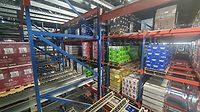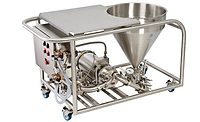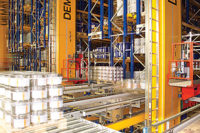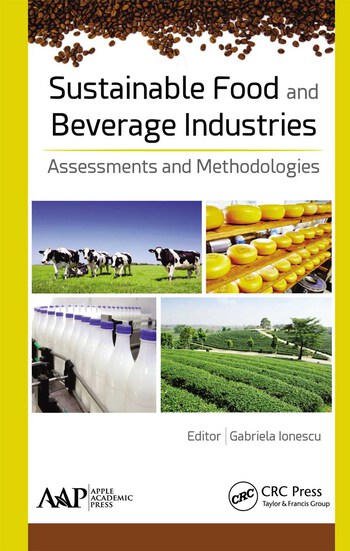Automation, data collection make robotics more appealing to beverage warehouses
Business case highlights benefits of robotic investment

Image courtesy of Swisslog Americas
Each episode title for fictional courtroom drama “Perry Mason,” begins with the verbiage “The Case of,” followed by a description of the pending client, setting the scene for whom the defense attorney will be representing.
When it comes to beverage operations, the incorporation of automation is laying the ground work to make a case for implementation of robotics.
“The business case for warehouse automation has never been stronger, and the return on investment has never been shorter,” says Bill Stenger, head of sales at Swisslog Americas, Atlanta. “Businesses, especially those in the beverage industry that handle large volumes of inventory, are benefiting from implementing automation solutions, such as pallet automation. Pallet automation streamlines the movement and storage of goods in a warehouse, reducing manual labor and increasing efficiency. This results in faster order processing, improved inventory management and lower operating costs.”
Greg Foreman, vice president of retail at DHL Supply Chain, Westerville, Ohio, explains that the company has seen its beverage industry customers receptive and even enthusiastic about robotics, with some even expanding its adoption.
Flexibility in robotic solutions resonates strongly with our customers, especially given the rapid product innovation and trends that can swiftly alter SKUs. Solutions that can scale up or down to match peak periods, rather than large, heavy capital intensive robotics, is crucial for adaptability given the dynamic nature of the beverage market.
“They particularly value solutions that deliver a satisfactory ROI and reduce turnover, as our warehouse associates enjoy working alongside robots,” he says. “Flexibility in robotic solutions resonates strongly with our customers, especially given the rapid product innovation and trends that can swiftly alter SKUs. Solutions that can scale up or down to match peak periods, rather than large, heavy capital intensive robotics, is crucial for adaptability given the dynamic nature of the beverage market.”
Among the ways that beverage operations are applying the use of robotics has been with pallet building, Swisslog’s Stenger explains.
“For most beverage companies, layer picking — both manual and with gantry — have been in use for a long time,” he says. “However, given that many retailers no longer want or need a whole layer of one product, mixed-case palletizing is growing in the beverage industry. As a result, pallet automation that enables mixed-case palletizing is becoming more important.”
To support these needs, Swisslog developed ACPaQ, a robotic and data-driven case picking and palletizing solution for store-ready order fulfilment, Stenger notes.
“The highly flexible solution takes single SKU inbound stock pallets, breaks them down to cases and builds them back up into mixed SKU outbound order pallets,” he says.
Scott Mabie, chief operating officer of Americas at OnRobot, Dallas, notes that traditional fixed robotic systems can impact capital expenditures in the range of millions, and align with industry giants. Yet, small and medium sized companies (SMEs) might benefit from more collaborative automation solutions.
“[I]f you look at small and medium sized companies (SMEs) that have less space in their facilities, or they have a more niche product, high mix/low volume product runs, then collaborative automation is a really good way to get into automation,” he says. “With our new D:PLOY automated programming platform integrated with one of our partner pre-engineered D:PLOY solutions, it’s also extremely easy to deploy and redeploy, which provides flexibility and added value.”
This comes as SKU proliferation has prompted the need for a range of robotic solutions.
“In order to automate high mix-low volume SKU handling, you need robotic systems that are easy to redeploy for product changeovers,” Mabie says. “In contrast to fixed, traditional automation, collaborative automation is highly versatile and can be moved in between applications and new products.”
Jordan Frank, co-founder and executive vice president of sales and solutions at Zion Solutions Group, Covington, Ky., notes that the beverage industry actually was an early adopter of robotics, leaning heavily on industrial automation. However, when goods to person/autonomous mobile robot (AMR) technology became the vanguard solution, beverage was not the primary target.
“[A]s these companies continue to expand the weight capacities and flexibility of product size, we are seeing more and more beverage companies dip their toe, and in some cases take a dive, in the water,” he says.
Although robotics often are highlighted for their impact on operations efficiencies, these solutions also can serve warehouse employees.
“Robotics can help beverage warehouses become more efficient while also increasing quality of life for their employees,” Frank explains. “Beverages aren’t known to be light in nature, constantly picking up and moving cases of cans or bottles will cause fatigue and potential work place injuries. AS/RS type systems can reduce or even eliminate the need for beverage warehouse employees to lift and move these heavier cases.”

AI at work
With consumer media covering the increasing use of artificial intelligence (AI) in a handful of ways, experts note that robotics already are seeing its impact.
“There are multiple types of artificial intelligence systems in the market,” Zion Solutions’ Frank says. “There is machine learning which is heavily used across the robotics market today. The best example of machine learning is with a pick and place robot, if a particular robot makes an error or grabs a case in the wrong orientation, there are tools that allow humans to interact and ‘teach’ the robot how to mitigate the error. That functionality has had a large impact on the efficiency and flexibility of robotics.”
Matthew Dippold, director of operations development at DHL Supply Chain, explains that machine learning AI technology has helped transform the warehouse robotics market.
“Enhanced 3D camera perception, quicker decision-making, and additional co-worker collaboration have increased the efficiency of use cases where robots are injected into the process,” he says. “These AI-powered robots are revolutionizing the way warehouses operate, leading to increased overall process productivity, reduced operating costs, and improved customer satisfaction. AI also allows for current robotic solutions to evolve to address other use cases.
“A good example of this is our Stretch robot, a robotic arm developed in partnership with Boston Dynamics that was deployed last year to unload floor-loaded cases from trailers, which is now learning to handle multiple cases at a time,” he continues. “In addition, we continue to explore other use cases in the warehouse where this technology can provide benefit to the operation.”
OnRobot’s Mabie notes that as the demand for AI increases, suppliers are developing more ways to improve accessibility to a range of beverages, with an end goal to improve revenue and profits for beverage manufacturers.
“In general terms, as robots have gotten ‘smarter’ they have also become easier to use,” Mabie says. “This is very exciting for OnRobot because we’re also trying to simplify automation deployments. Our D:PLOY platform, for example, uses AI to allow users to skip programming completely ― slashing deployment times in the process.
“Instead of reinventing the wheel every time we deploy a robot and spending extreme amounts of time using experts to program robots, D:PLOY can do the programming for you based on a few user inputs,” he continues. “And that almost effortless usability versus traditional deployment approaches is the whole goal of OnRobot, and of the automation and AI sectors in general.”
Swisslog’s Stenger highlights how AI will make future warehouses more dynamic.
“It is enabling robotics to self-learn from experience, which means that robotic picking ability improves over time with enhanced picking strategies for new products,” he says. “For example, Swisslog recently introduced the latest evolution of its robot-based item picking system, ItemPiQ. It features significant improvements made possible by advanced AI capabilities, such as context-aware picking and improved item recognition. ItemPiQ is designed for repeated, reliable picking of a wide range of items to fulfill fast delivery of orders at low operating costs, streamlining and improving the order picking process.”
Stenger adds that AI will continue to have an impact on the optimization of warehouses.
“A lot of AI effort is going to be focused on facilitating more automation in the distribution center. That, in turn, drives more sophistication, including more sophisticated AI,” he says. “Companies, including those in the beverage industry, are looking for intelligent software that will help make decisions on how to run operations. So, the AI and systems ability to orchestrate the flow is where AI will become powerful in the future. It will make suggestions on which inventory should go where or find predictive models for inventory considerations.”
Zion Solutions’ Frank, meanwhile, notes that generative AI is not as widely used, but could have a major impact on robotics when that time comes.
“Once Generative AI is implemented in the robotics market, I would expect to have a robotic revolution, meaning huge advancements in the capabilities of robots within a short period of time,” he says. “Humanoid Robots, in my opinion, are the most primed to utilize generative AI.”
Frank further prognosticates that Humanoids and generative AI will be a game-changer for the robotics market.
“As it stands today, most robotic systems need cases or products to be presented a certain way to work their best, furthermore, exceptions continue to be a big topic with different robotic OEMs,” he says. “As robotics improve, I would expect to have less exceptions and be able to integrate robotics easier into existing environments instead of requiring retrofits.”
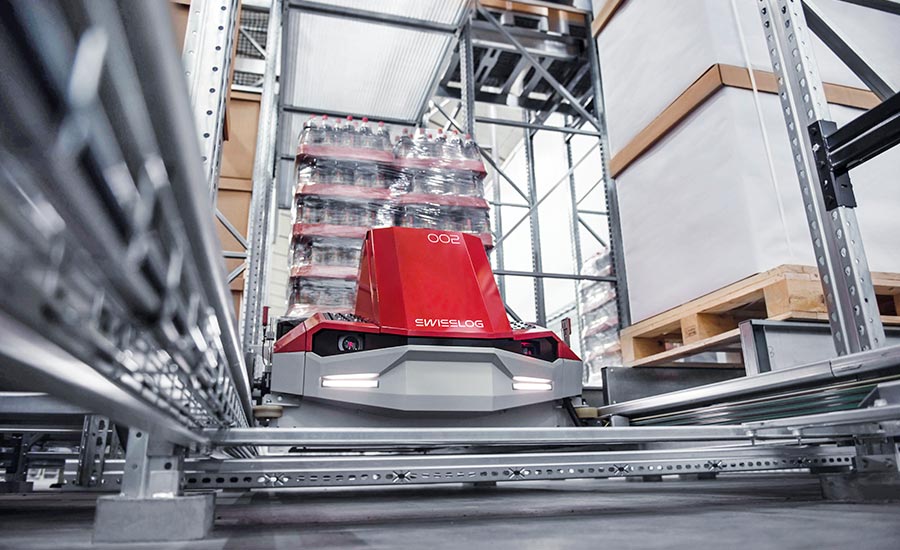
A sense of innovation
For operations managers analyzing where robotics could fit into their day-to-day tasks, experts highlight the advancements that are fueling this industry.
“Advancements in sensors, actuators, and materials, have enabled robots to become more capable, efficient and adaptable,” DHL’s Dippold says. “For example, LiDAR (Light Detection and Ranging) provides precise distance measurements, enabling robots to navigate complex environments accurately. LiDAR technology has advanced dramatically over the past few years allowing for detection at greater distances. Coupled with the improvement/response time of machine learning through AI, onboard safety systems have evolved to improve the overall safety of working around these robots.
“Depth cameras, similar to LiDAR, use infrared light to create 3D maps of the environment and force sensors also allow robots to detect and respond to physical interactions with objects,” he continues. “These capabilities are particularly important in a warehouse environment where robots operate alongside humans.”
Additionally, as warehouses have experienced staffing challenges, suppliers are working to make their platforms more accessible in regards to working with the program.
“The accessibility of robotics through easier programming eliminates the need for highly skilled programmers for every new application and the redeployment of existing robotics,” OnRobot’s Mabie says. “The emergence of collaborative automation (using collaborative robots and light industrial robots) has really shown the industry that there is automation out there that is effective, affordable, and easy to use. At the same time, electric tooling has made many improvements and found a perfect fit with the rise of cobot and lightweight industrial robot arms.
“Today, a lot of the excitement is about software. Instead of end users needing expertise to set up a palletizing application, for example, they can, using a OnRobot pre-engineered partner solution with the programming platform like D:PLOY, simply plug their electric end effector on to their collaborative robot (cobot) and be up and running within minutes,” he continues. “The same applications used to take days to set up and deploy. The dual rise of collaborative automation and software that reduces deployment time to a fraction are the most significant technological improvements.”
Swisslog’s Stenger also highlights the impact that software is having on robotics solutions.
“As the software that controls automation continues to advance, it has become at least as important to the success of a project as the automation technology itself,” he says. “Key software requirements for food and beverage manufacturers tend to center on inventory management, traceability and process efficiency.”
Stenger adds that companies should ask a host of important questions when integrating software, including but not limited to “can the automation software manage inventory with extended attributes, such as batch, expiry date, best-by date or any other factors important to your business?”
Operations managers also should ask what support the software can deliver in terms of precision to inventory tracking movement, interweaving of manual and automated processes and whether one is allowed access and control of all aspects within a single interface.
“A mature, modular software platform that includes functionality traditionally included in WMS but with the automation enablement of a WES and WCS, such as the Swisslog SynQ platform, will have all of these critical capabilities included in a standardized offering,” Stenger says.
Robotics solutions also have seen the sophistication of vision and data collection capabilities in recent years.
“Another technology that is aiding the robotics market is vision systems, such as cameras that read and determine not only what is in a case, but also capture the dimensional data,” Stenger says. “This feeds into the idea that the more data you have, the more reliable your automation system can be. This sort of data, combined with software improvements are making robotics more effective and affordable to reconfigure pallets on the fly.”
Zion Solutions’ Frank also highlights the effect this has had on robotics.
“The ability to continually improve systems in real world scenarios continues to be the best way to improve robotic capabilities,” he says. “Furthermore, the improvement of software has been a critical reason we are starting to see robotics applied across more industries or verticals.”
Looking for a reprint of this article?
From high-res PDFs to custom plaques, order your copy today!




